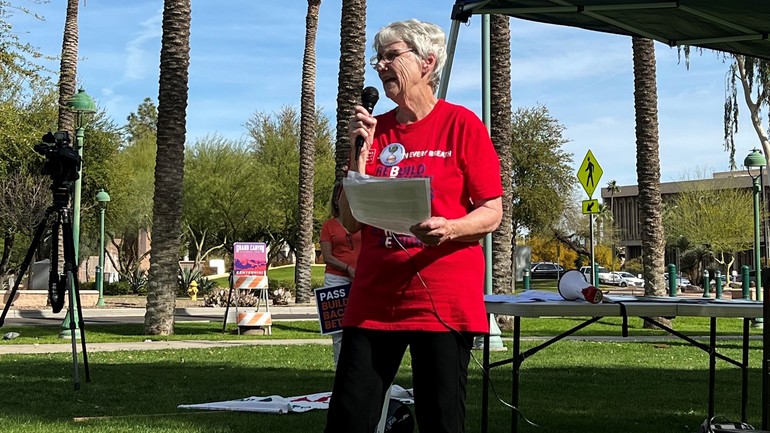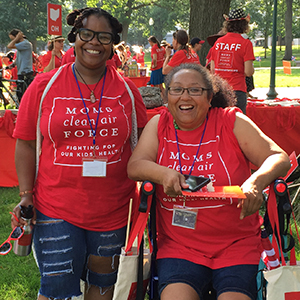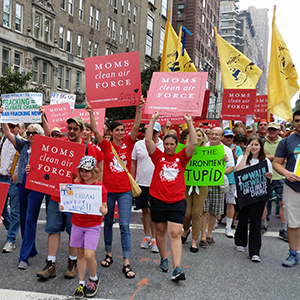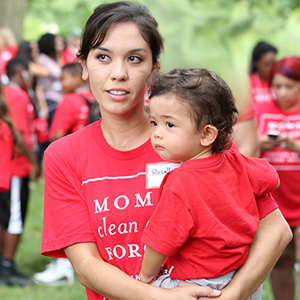
This was written by Moms Clean Air Force’s Arizona field coordinator Hazel Chandler.
Air pollution has been a dangerous constant in my life for as long as I can remember. As a mom, grandmother, and great-grandmother who lives with asthma, respiratory issues, chronic inflammation, immune dysfunction, and stage 4 cancer, I’m all too familiar with the grave danger pollution poses to our communities and our bodies. I may not be alive to see the results of a lifetime of advocacy for clean air, but I think of this work as my legacy for my children, grandchildren, and great-grandchildren.
The good news is that President Biden and US Environmental Protection Agency (EPA) Administrator Michael Regan have an opportunity to take a significant step forward in fighting deadly particle pollution—also known as PM 2.5 or soot. Soot pollution—which comes from power plants, vehicles, and other industrial sources—poses a special danger for the most vulnerable people in our communities. That includes kids, seniors, and people like me who suffer from chronic illnesses. These particles are microscopically small—about 1/36th the size of a grain of sand—and can be inhaled into our lungs and delivered directly to our bloodstream. Exposure to soot can cause inflammation and is linked to many health risks and chronic conditions, including asthma, heart disease, respiratory disease, cancer, dementia, and adverse birth outcomes.
The bad news is that pollution is no small problem: it affects millions of people each year. According to the American Lung Association, 63 million people in the US live in counties with an F grade for short-term spikes in soot pollution, and more than 20 million suffer dangerous levels of soot pollution on a year-round basis. The current air quality standards for soot haven’t been updated since 2012 and are insufficient to protect our health or the environment.
At the beginning of 2023, EPA proposed a revised soot standard. While it is a step in the right direction, it doesn’t go far enough. With stronger, updated limits on soot pollution—no higher than 8 mcg/m3 for the annual standard and 25 mcg/m3 for the daily standard—EPA can save nearly 20,000 lives each year. In communities of color and communities that are historically overburdened by pollution, a stronger soot standard is critical to addressing some of the well-known racial disparities in health outcomes. In addition, by tightening soot protections, other dangerous pollution from these sources will be reduced.
The current soot proposal doesn’t meet the mark: bold action is needed if we are to meet the president’s commitments to cut dangerous pollution, protect our health, and advance environmental justice. EPA needs to consider and finalize the strongest possible standards, consistent with what its independent, outside scientific experts support. That is why I recently made my voice heard at the agency’s public hearing on its soot pollution standard. Alongside so many of my colleagues at Moms Clean Air Force and throughout our community, we made the case that the Biden administration must follow the science and set the strong standards we need to protect our health.
I am determined to make sure my children and grandchildren have a healthier, safer community to call home than I did. While pollution has sadly damaged my quality of life, it doesn’t have to be that way for future generations. Parents around the country are counting on EPA to protect our kids’ health now and in the future by setting strong soot standards and other solutions for pollution. We simply cannot afford to miss this opportunity to meaningfully address air pollution and act on environmental justice. The annual and 24-hour soot standards must be strengthened without delay.
Air pollution knows no bounds. It doesn’t care about state borders or your political identity. We need President Biden and Administrator Regan to heed the calls from their own science advisors and set stronger soot pollution standards now because too much is at stake. Every day we wait means more soot in our air as more people in the US are faced with grave health consequences like the ones I’m experiencing. When it comes to our health and our lives, time is precious—and we have no time to waste.
TELL EPA: WE NEED THE STRONGEST POSSIBLE CLEAN CAR STANDARDS




